eye support

free shipping over $100 (USA & Canada)
1-877-937-4372 the pet expert hotline


We all know that conjunctivitis is a condition that usually pops up at some stage, whether young, old, healthy, or sick. Any pet can also end up with conjunctivitis. For those that don’t know, anything ending in “itis” generally means that the specific area is inflamed and infected. In this case, conjunctivitis in pets refers to an infection of the eye.
Contagious conjunctivitis seems to be more common in cats than in dogs.
The tissue that covers the eye and the inner surface of the eyelid are called the conjunctiva. Conjunctivitis means that the conjunctiva is inflamed. It can be caused by many different factors such as bacteria, viruses, allergies, trauma, and different irritants. It may not always be infectious; therefore, it may not transfer from one pet to another but it CAN also be contagious.
Contagious conjunctivitis seems to be more common in cats than in dogs. This is caused by different bacteria or viruses. Conjunctivitis in dogs can be more commonly caused by an underlying issue or a seasonal allergy.

Many of the symptoms associated with this condition are restricted to the eye area. There will be:
Conjunctivitis is not something that should be attempted to treat at home. It is always best to take your pet to a veterinarian to ensure there are no underlying conditions or possible damage to the eye itself. When you notice these symptoms, it is advised to have this looked at as soon as possible.
One of the main reasons that it’s important for your pet to get checked, is due to there being many different types of conjunctivitis. These different types can range from minor to severe and if you tried to treat the more severe case with home remedies, it most likely will not have any effect. The more severe cases can relate to conditions such as disorders of the tear duct, corneal diseases, eyelid abnormalities, or parasites.
A vet will put Fluorescein (Fluorescein is a dye that will detect corneal ulcers or any abrasions on the eye) into the eye. It is a green dye that glows under blue light and if there is damage to the cornea, the dye will stain the eye. When the dye sticks to the damaged area, it will show the veterinarian where the damage is and how big/small the issue is.
The Schirmer tear test will detect whether the eye is producing enough tears to lubricate the eye. There are additional tests that can also be performed to detect any bacteria, distemper, or glaucoma.

Most cases of conjunctivitis can be treated by applying eye drops and ointments to the eye. When conjunctivitis is related to a more serious condition then antibiotics and other medication may be prescribed to administer orally. When the guidelines and treatment are followed correctly, the eye will have a very good chance of healing within a few days.
There are many other reasons why a pet may have conjunctivitis such as entropion. Entropion means that the eyelid is deformed and the eyelashes grow inwards causing damage to the eye. This condition would require surgical attention in order to correct it.
Other issues such as dry eye, can be a long-term issue and will require treatment for the rest of your pet’s life. This can also be managed by applying drops daily.
It is always a good idea to revisit the vet to ensure that the eye is healing correctly and responding well to the advised treatment. For severe cases, the eye may need to be removed to prevent further discomfort and inflammation. Though this is rare, removal of the eye can be more common in breeds where the eyes are bulging.
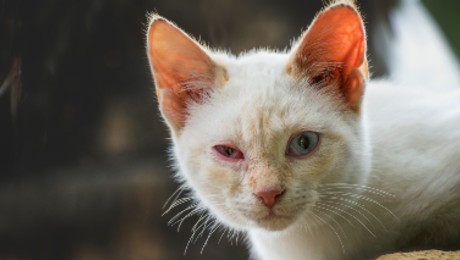
Not all causes of conjunctivitis can be avoided but for the most part, it can be prevented. Pet parents should be careful with airborne irritants that their pets can be exposed to such as cigarette smoke. For pets with eyes that are more exposed, playtime should be monitored. Vaccines can also be a great preventative measure against certain viruses that may cause problems with the eye. Diseases like the distemper and herpes virus can also cause conjunctivitis.
Our pet experts advise using Ey-Eas. It’s our herbal formula that contains antibiotic and anti-inflammatory activities for conjunctivitis and watery eyes. This formula is gentle and non-irritating and it will support the management of uncomfortable swelling, soothe uncomfortable itching, and help control discharge. Ey-Eas can also help prevent the infection of other pets as conjunctivitis can be contagious in some cases.
Ey-Eas can be applied topically to the eye 2-3 times a day.
NHV OcuLove is our new vet-formulated supplement for eye health. It is designed to only be taken orally and contains a blend of herbs that are beneficial for fighting eye infections, supporting tear stains, reducing inflammation, and encouraging overall healthy eyes.
If you have any other questions about conjunctivitis in pets and what you can do to support your pet naturally, feel free to reach out to our pet experts. We are always happy to help.
eye support

To Manage Uncomfortable Swelling and Restore Eye Health from Pink Eye (Conjunctivitis) and Watery Eyes
buy 2 and save $3
Ey-Eas is a dog eye infection remedy that helps soothe discomfort, stressful eye infections and in dogs due to foreign material, bacteria or viral infections such as pink eye (conjunctivitis).

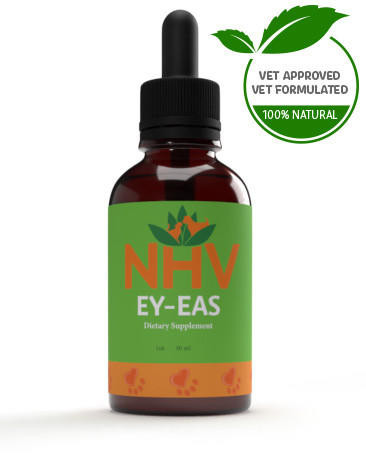
Ey-Eas is a dog eye infection remedy that helps soothe discomfort, stressful eye infections and in dogs due to foreign material, bacteria or viral infections such as pink eye (conjunctivitis).

Dogs may be prone to eye infections that cause discomfort and long-term damage if left untreated. Ey-Eas is a dog eye infection remedy that helps dogs with eyes that are red, cloudy, or bulging. It is also helpful for dogs that are continually rubbing their eyes, tearing excessively, or avoiding light. Conjunctivitis can occur in one or both eyes and is most often the result of a bacterial or viral infection.
Other possible causes include allergies, irritants, and fungal infections. If only one eye is affected, then it may be an inflamed tear sac or a foreign object causing the problem. Do not use with existing corneal ulcers.
Disclaimer: The information provided in relation to the products mentioned is intended for general informational purposes only and should not be construed as professional veterinary advice or a substitute for consultation with a qualified veterinarian. These products are not intended to diagnose, treat, cure, or prevent any pet health condition. Consult a licensed veterinarian before using any product or making changes to your pet's diet, health, or wellness routine. Individual pet health outcomes may vary, and the effectiveness of the product may depend on various factors specific to your pet. Always carefully read and follow the product label and instructions. The manufacturer and distributor of these products do not assume any liability for any direct or indirect consequences that may arise from the use of these products on pets. All information is for educational purposes only.
Chamomile – An excellent calming agent.
Eye Bright – Reduces inflammation and contains strong astringent properties.
Goldenseal – An anti-inflammatory and decongestant that exhibits a broad spectrum of antibiotic activity that works as a dog eye infection natural remedy.
Rosemary – Has anti-inflammatory and antiseptic properties.
Ey-Eas can be used orally or topically.
ORALLY: To be taken twice daily.
1 drops for every 2lb of body weight up to 50 lb.
TOPICALLY: Using the dropper place a few drops in each eye.
Shaking of the head and rubbing of the eyes is normal.
How to Administer
Shake well before use. The easiest method is to use the dropper provide and places the drops into your pet’s food or favorite treat. You can also use the dropper and squirt directly into the pet’s mouth.
Some pets can be finicky, if this occurs consider hiding the drops in foods most pet’s love such as fish, chicken or yogurt or a favorite treat. If your pet only eats dry food then soak a few kibbles at feeding time.
For Best Results
Herbal dietary supplements are beneficial to the health and wellbeing of your pet and are safe for long-term use. Every pet responds to natural herbal supplements differently, therefore it is important to be consistent and administer the product daily. Supplements generally take two to four weeks to take effect, however this will vary from one animal to the next.
Product Storage
All NHV Natural Pet Products are pure herbal extracts and contain no artificial additives, preservatives or coloring. Shelf life after opening is 6 months and must be refrigerated after opening.
Cautions and Contraindications
Do not use Ey-Eas in pregnant or nursing animals. When used topically the pet may shake it’s head or rub its eyes and face for a short time; this normal. Speak to your vet before using our products. A second visit is recommended if your pet’s condition does not improve, or deteriorates after continued use of the supplements.
All information provided by NHV Natural Pet Products is for educational purposes only.
Dogs may be prone to eye infections that cause discomfort and long-term damage if left untreated. Ey-Eas is a dog eye infection remedy that helps dogs with eyes that are red, cloudy, or bulging. It is also helpful for dogs that are continually rubbing their eyes, tearing excessively, or avoiding light. Conjunctivitis can occur in one or both eyes and is most often the result of a bacterial or viral infection.
Other possible causes include allergies, irritants, and fungal infections. If only one eye is affected, then it may be an inflamed tear sac or a foreign object causing the problem. Do not use with existing corneal ulcers.
Disclaimer: The information provided in relation to the products mentioned is intended for general informational purposes only and should not be construed as professional veterinary advice or a substitute for consultation with a qualified veterinarian. These products are not intended to diagnose, treat, cure, or prevent any pet health condition. Consult a licensed veterinarian before using any product or making changes to your pet's diet, health, or wellness routine. Individual pet health outcomes may vary, and the effectiveness of the product may depend on various factors specific to your pet. Always carefully read and follow the product label and instructions. The manufacturer and distributor of these products do not assume any liability for any direct or indirect consequences that may arise from the use of these products on pets. All information is for educational purposes only.
Chamomile – An excellent calming agent.
Eye Bright – Reduces inflammation and contains strong astringent properties.
Goldenseal – An anti-inflammatory and decongestant that exhibits a broad spectrum of antibiotic activity that works as a dog eye infection natural remedy.
Rosemary – Has anti-inflammatory and antiseptic properties.
Ey-Eas can be used orally or topically.
ORALLY: To be taken twice daily.
1 drops for every 2lb of body weight up to 50 lb.
TOPICALLY: Using the dropper place a few drops in each eye.
Shaking of the head and rubbing of the eyes is normal.
How to Administer
Shake well before use. The easiest method is to use the dropper provide and places the drops into your pet’s food or favorite treat. You can also use the dropper and squirt directly into the pet’s mouth.
Some pets can be finicky, if this occurs consider hiding the drops in foods most pet’s love such as fish, chicken or yogurt or a favorite treat. If your pet only eats dry food then soak a few kibbles at feeding time.
For Best Results
Herbal dietary supplements are beneficial to the health and wellbeing of your pet and are safe for long-term use. Every pet responds to natural herbal supplements differently, therefore it is important to be consistent and administer the product daily. Supplements generally take two to four weeks to take effect, however this will vary from one animal to the next.
Product Storage
All NHV Natural Pet Products are pure herbal extracts and contain no artificial additives, preservatives or coloring. Shelf life after opening is 6 months and must be refrigerated after opening.
Cautions and Contraindications
Do not use Ey-Eas in pregnant or nursing animals. When used topically the pet may shake it’s head or rub its eyes and face for a short time; this normal. Speak to your vet before using our products. A second visit is recommended if your pet’s condition does not improve, or deteriorates after continued use of the supplements.
All information provided by NHV Natural Pet Products is for educational purposes only.
immune & allergy support
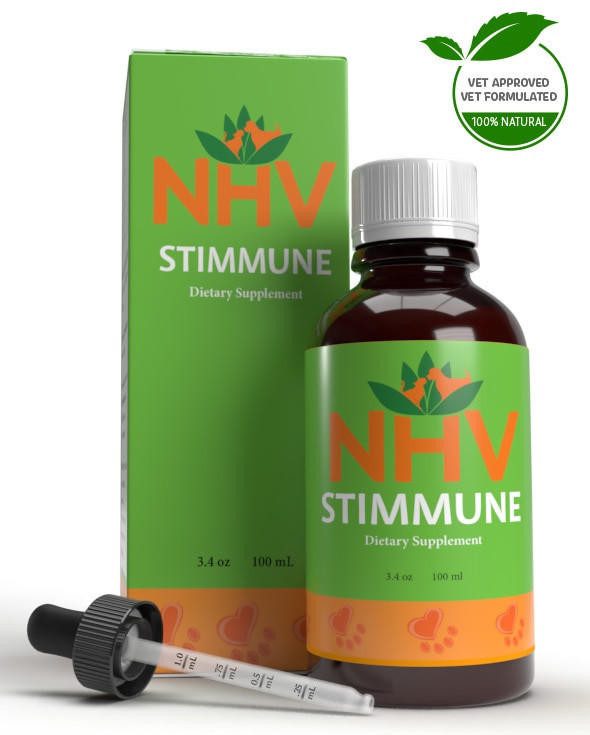
Holistic Remedy for Food Allergies and Immune Support in Cats
buy 2 and save $3
3 month supply for a small to medium size
Helps your cat overcome food allergies, skin allergies, and fight infection.

Helps your cat overcome food allergies, skin allergies, and fight infection.
Cats can be allergic to the things they eat and touch, just like people can. With NHV’s Stimmune, your kitty will get potent immune supporting herbs that help support your cat with food allergy reactions, as well as reactions related to fleas, dermatitis, insect bites, diet, and exposure to chemicals and drugs. For seasonal or environmental allergies, please try Alge-Ex for a remedy specifically formulated for your cat.
At NHV, all of our pet products are formulated by a master herbalist as well as a holistic veterinarian having more than 20 years of experience. Some ingredients are even wild-crafted which means they were ethically harvested from their natural environment. Our products are also safe for long-term use and are supplements that animals like to take, including finicky kitties.
If you have questions about holistic remedies for cat allergies to food or any of our wide variety of products, you can ask an NHV expert. Our very supportive professional team of pet experts are here to help and recommend supplements because, at NHV, we want your kitty feeling pawtastic naturally!
Stimmune Is Also Helpful for:
Cats can get food allergies from their diet, and other allergies from their environment when allergens are inhaled, ingested, or absorbed by the body. Once this happens, the immune system overreacts, and this is when your kitty will need extra balance and support.
Read about a senior cat’s Helenda’s transformation using Stimmune.
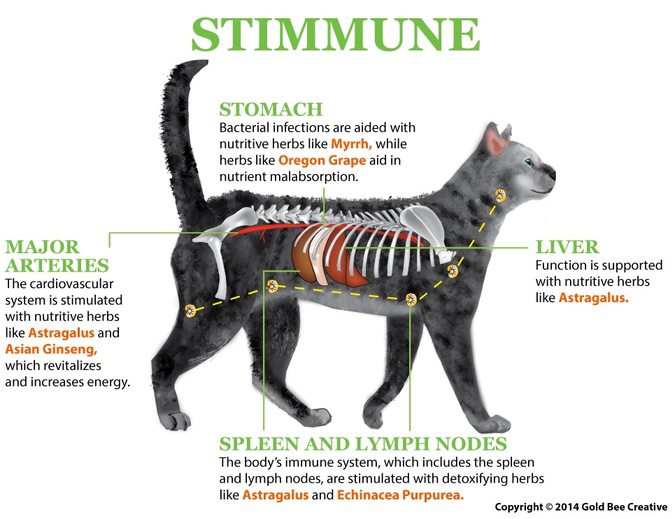
How NHV’s Stimmune Helps Allergies in Cats
Stimmune promotes healthy immune activity and histamine response with five natural herbs formulated to reduce environmental allergies in cats.
Stimmune provides support in addition to conventional treatment for all forms of allergies including pollen allergies in cats.
Select your pet's weight to determine the correct dose.
Cats can be allergic to the things they eat and touch, just like people can. With NHV’s Stimmune, your kitty will get potent immune supporting herbs that help support your cat with food allergy reactions, as well as reactions related to fleas, dermatitis, insect bites, diet, and exposure to chemicals and drugs. For seasonal or environmental allergies, please try Alge-Ex for a remedy specifically formulated for your cat.
At NHV, all of our pet products are formulated by a master herbalist as well as a holistic veterinarian having more than 20 years of experience. Some ingredients are even wild-crafted which means they were ethically harvested from their natural environment. Our products are also safe for long-term use and are supplements that animals like to take, including finicky kitties.
If you have questions about holistic remedies for cat allergies to food or any of our wide variety of products, you can ask an NHV expert. Our very supportive professional team of pet experts are here to help and recommend supplements because, at NHV, we want your kitty feeling pawtastic naturally!
Stimmune Is Also Helpful for:
Cats can get food allergies from their diet, and other allergies from their environment when allergens are inhaled, ingested, or absorbed by the body. Once this happens, the immune system overreacts, and this is when your kitty will need extra balance and support.
Read about a senior cat’s Helenda’s transformation using Stimmune.

How NHV’s Stimmune Helps Allergies in Cats
Stimmune promotes healthy immune activity and histamine response with five natural herbs formulated to reduce environmental allergies in cats.
Stimmune provides support in addition to conventional treatment for all forms of allergies including pollen allergies in cats.
Select your pet's weight to determine the correct dose.
immune & allergy support
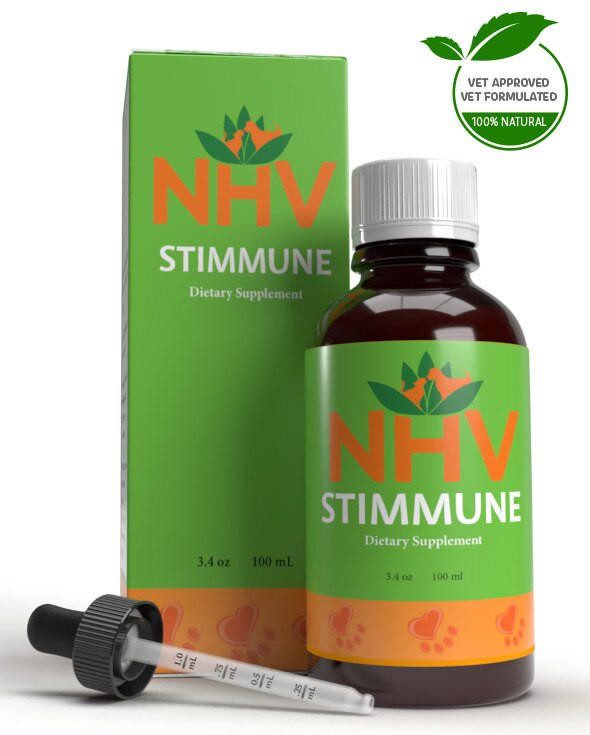
Natural Dog Food Allergy Supplement and Immune Support.
buy 2 and save $3
3 month supply for a small to medium size
Soothes food allergies, skin allergies (dermatitis), and infection. Helps relieve a variety of symptoms related to allergies. Supports a healthy balance of the immune system in pets with conditions such as autoimmune disease.

Soothes food allergies, skin allergies (dermatitis), and infection. Helps relieve a variety of symptoms related to allergies. Supports a healthy balance of the immune system in pets with conditions such as autoimmune disease.
Stimmune helps balance the immune system and helps ease allergy symptoms that can make your dog miserable. Stimmune is an all-natural, vet-formulated dog allergy immune supplement that will help your pet deal with dog food allergies as well as other immune related disorders.
Stimmune can provide dog allergy help with allergic reactions related to food, as well as environmental allergies including reactions to fleas, insect bites, food and other environmental factors. For more acute seasonal or environmental allergies, please try Alge-Ex for a remedy specifically formulated for your dog.
An allergy is an overreaction of the immune system to a normally harmless substance called an antigen. Allergies in dogs often occur when allergens are inhaled, ingested, or absorbed by the body. When this occurs, the immune system becomes over-reactive to substances it believes are harmful. This reaction causes a release of histamine, causing the common allergy symptoms in your pet.
The cause of allergies in dogs can be difficult to determine. While it is always best to eliminate the cause altogether, like omitting a specific food from their diet, some causes can be nearly impossible to totally eradicate, like dust mites or pollen. This is where a dog allergy supplement that is taken daily can help relieve your loved one of common allergens, even when you're not exactly sure what they are allergic to.
Dog food allergy support is close at hand with Stimmune added into your pet’s daily regimen. This 100% natural herbal supplement was formulated by a holistic veterinarian to comprehensively care for your pet’s health.
Explore our Pet Expert Q&A to ask questions about your pet’s allergic reactions or view questions that other concerned pet owners like you have posted. Or, visit our blog to learn how to prevent food allergies in dogs and cats.

Astragalus – Stimulates liver function and helps balance the immune system. High in antioxidants it also helps protect against oxidative damage.
Echinacea Purpurea – Reduces inflammation, helps boost the immune system and efficiently fights infection.
Oregon Grape – Has antibiotic, anti-inflammatory and immunostimulatory properties.
Asian Ginseng – Has been used for thousands of years to help against various health issues. This antioxidant herb helps balance the immune system, helps the body fight infections and helps the body cope against stress.
Myrrh – An astringent that relieves irritated skin, Myrrh is high in anti-inflammatory and antioxidant effects.
Select your pet's weight to determine the correct dose.
To be taken twice daily. Determine your pet’s weight and then use the easy chart below to determine the correct dose. This is the minimum dosage.
Pet's Weight Dosage
0 - 15 lb = 0.5 ml
16 - 30 lb = 1.0 ml
31 - 45 lb = 1.5 ml
46 - 60 lb = 2.0 ml
61 - 75 lb = 2.5 ml
Over 75 lb = 3.0 ml
For small animals (rabbits, ferrets), avians and reptiles use 1 drop for every 2 lb of body weight.
How to Administer
Shake well before use. The easiest method is to use the dropper provide and places the drops into your pet’s food or favorite treat. You can also use the dropper and squirt directly into the pet’s mouth.
Some pets can be finicky, if this occurs consider hiding the drops in foods most pet’s love such as fish, chicken or yogurt or a favorite treat. If your pet only eats dry food then soak a few kibbles at feeding time.
For Best Results
Herbal dietary supplements are beneficial to the health and wellbeing of your pet and are safe for long-term use. Every pet responds to natural herbal supplements differently, therefore it is important to be consistent and administer the product daily. Supplements generally take two to four weeks to take effect, however this will vary from one animal to the next.
Product Storage
All NHV Natural Pet Products are pure herbal extracts and contain no artificial additives, preservatives or coloring. Shelf life after opening is 6 months and must be refrigerated after opening.
Cautions and Contraindications
Do not use Stimmune in pregnant or nursing animals. Speak to your vet before using our products. A second visit is recommended if your pet’s condition does not improve, or deteriorates after continued use of the supplements.
All information provided by NHV Natural Pet Products is for educational purposes only.
Stimmune helps balance the immune system and helps ease allergy symptoms that can make your dog miserable. Stimmune is an all-natural, vet-formulated dog allergy immune supplement that will help your pet deal with dog food allergies as well as other immune related disorders.
Stimmune can provide dog allergy help with allergic reactions related to food, as well as environmental allergies including reactions to fleas, insect bites, food and other environmental factors. For more acute seasonal or environmental allergies, please try Alge-Ex for a remedy specifically formulated for your dog.
An allergy is an overreaction of the immune system to a normally harmless substance called an antigen. Allergies in dogs often occur when allergens are inhaled, ingested, or absorbed by the body. When this occurs, the immune system becomes over-reactive to substances it believes are harmful. This reaction causes a release of histamine, causing the common allergy symptoms in your pet.
The cause of allergies in dogs can be difficult to determine. While it is always best to eliminate the cause altogether, like omitting a specific food from their diet, some causes can be nearly impossible to totally eradicate, like dust mites or pollen. This is where a dog allergy supplement that is taken daily can help relieve your loved one of common allergens, even when you're not exactly sure what they are allergic to.
Dog food allergy support is close at hand with Stimmune added into your pet’s daily regimen. This 100% natural herbal supplement was formulated by a holistic veterinarian to comprehensively care for your pet’s health.
Explore our Pet Expert Q&A to ask questions about your pet’s allergic reactions or view questions that other concerned pet owners like you have posted. Or, visit our blog to learn how to prevent food allergies in dogs and cats.

Astragalus – Stimulates liver function and helps balance the immune system. High in antioxidants it also helps protect against oxidative damage.
Echinacea Purpurea – Reduces inflammation, helps boost the immune system and efficiently fights infection.
Oregon Grape – Has antibiotic, anti-inflammatory and immunostimulatory properties.
Asian Ginseng – Has been used for thousands of years to help against various health issues. This antioxidant herb helps balance the immune system, helps the body fight infections and helps the body cope against stress.
Myrrh – An astringent that relieves irritated skin, Myrrh is high in anti-inflammatory and antioxidant effects.
Select your pet's weight to determine the correct dose.
To be taken twice daily. Determine your pet’s weight and then use the easy chart below to determine the correct dose. This is the minimum dosage.
Pet's Weight Dosage
0 - 15 lb = 0.5 ml
16 - 30 lb = 1.0 ml
31 - 45 lb = 1.5 ml
46 - 60 lb = 2.0 ml
61 - 75 lb = 2.5 ml
Over 75 lb = 3.0 ml
For small animals (rabbits, ferrets), avians and reptiles use 1 drop for every 2 lb of body weight.
How to Administer
Shake well before use. The easiest method is to use the dropper provide and places the drops into your pet’s food or favorite treat. You can also use the dropper and squirt directly into the pet’s mouth.
Some pets can be finicky, if this occurs consider hiding the drops in foods most pet’s love such as fish, chicken or yogurt or a favorite treat. If your pet only eats dry food then soak a few kibbles at feeding time.
For Best Results
Herbal dietary supplements are beneficial to the health and wellbeing of your pet and are safe for long-term use. Every pet responds to natural herbal supplements differently, therefore it is important to be consistent and administer the product daily. Supplements generally take two to four weeks to take effect, however this will vary from one animal to the next.
Product Storage
All NHV Natural Pet Products are pure herbal extracts and contain no artificial additives, preservatives or coloring. Shelf life after opening is 6 months and must be refrigerated after opening.
Cautions and Contraindications
Do not use Stimmune in pregnant or nursing animals. Speak to your vet before using our products. A second visit is recommended if your pet’s condition does not improve, or deteriorates after continued use of the supplements.
All information provided by NHV Natural Pet Products is for educational purposes only.
Published: May 15, 2020